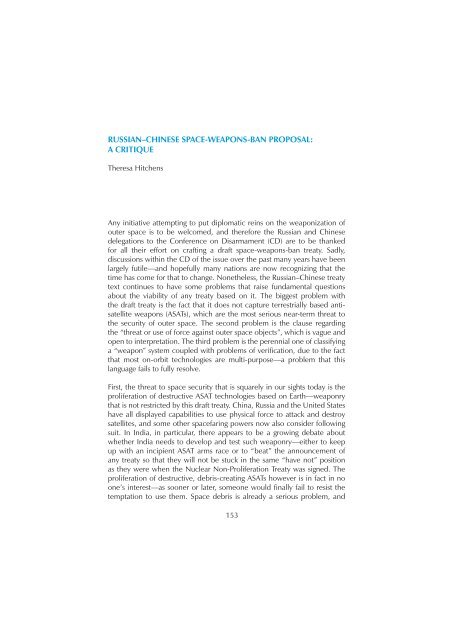Security in Space The Next Generation - UNIDIR
Security in Space The Next Generation - UNIDIR
Security in Space The Next Generation - UNIDIR
Create successful ePaper yourself
Turn your PDF publications into a flip-book with our unique Google optimized e-Paper software.
RUSSIAN–CHINESE SPACE-WEAPONS-BAN PROPOSAL:<br />
A CRITIQUE<br />
<strong>The</strong>resa Hitchens<br />
Any <strong>in</strong>itiative attempt<strong>in</strong>g to put diplomatic re<strong>in</strong>s on the weaponization of<br />
outer space is to be welcomed, and therefore the Russian and Ch<strong>in</strong>ese<br />
delegations to the Conference on Disarmament (CD) are to be thanked<br />
for all their effort on craft<strong>in</strong>g a draft space-weapons-ban treaty. Sadly,<br />
discussions with<strong>in</strong> the CD of the issue over the past many years have been<br />
largely futile—and hopefully many nations are now recogniz<strong>in</strong>g that the<br />
time has come for that to change. Nonetheless, the Russian–Ch<strong>in</strong>ese treaty<br />
text cont<strong>in</strong>ues to have some problems that raise fundamental questions<br />
about the viability of any treaty based on it. <strong>The</strong> biggest problem with<br />
the draft treaty is the fact that it does not capture terrestrially based antisatellite<br />
weapons (ASATs), which are the most serious near-term threat to<br />
the security of outer space. <strong>The</strong> second problem is the clause regard<strong>in</strong>g<br />
the “threat or use of force aga<strong>in</strong>st outer space objects”, which is vague and<br />
open to <strong>in</strong>terpretation. <strong>The</strong> third problem is the perennial one of classify<strong>in</strong>g<br />
a “weapon” system coupled with problems of verifi cation, due to the fact<br />
that most on-orbit technologies are multi-purpose—a problem that this<br />
language fails to fully resolve.<br />
First, the threat to space security that is squarely <strong>in</strong> our sights today is the<br />
proliferation of destructive ASAT technologies based on Earth—weaponry<br />
that is not restricted by this draft treaty. Ch<strong>in</strong>a, Russia and the United States<br />
have all displayed capabilities to use physical force to attack and destroy<br />
satellites, and some other spacefar<strong>in</strong>g powers now also consider follow<strong>in</strong>g<br />
suit. In India, <strong>in</strong> particular, there appears to be a grow<strong>in</strong>g debate about<br />
whether India needs to develop and test such weaponry—either to keep<br />
up with an <strong>in</strong>cipient ASAT arms race or to “beat” the announcement of<br />
any treaty so that they will not be stuck <strong>in</strong> the same “have not” position<br />
as they were when the Nuclear Non-Proliferation Treaty was signed. <strong>The</strong><br />
proliferation of destructive, debris-creat<strong>in</strong>g ASATs however is <strong>in</strong> fact <strong>in</strong> no<br />
one’s <strong>in</strong>terest—as sooner or later, someone would fi nally fail to resist the<br />
temptation to use them. <strong>Space</strong> debris is already a serious problem, and<br />
153








